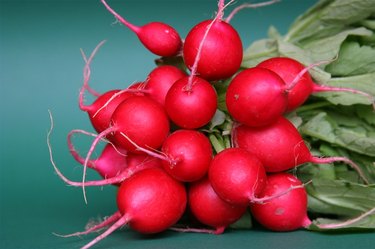
The crunchy red and white roots of the radish (Raphanus sativus), also known as summer radish, are generally used fresh in salads or as a peppery-sweet snack. The entire life cycle of a radish extends from early spring into summer. Its close relative, the winter or daikon radish (Raphanus sativus var. longipinnatus), produces up to 36-inch-long roots that are enjoyed fresh or cooked or as pickles. While generally grown as annuals, daikons will continue growing through the winter and bloom in spring and early summer in U.S. Department of Agriculture plant hardiness zones 9 through 11.
Start With the Seeds
Video of the Day
The life cycle of a radish starts with the seeds. These members of the mustard family thrive in cool temperatures between 50 and 75 degrees Fahrenheit. Cultivate a full-sun, well-drained garden bed and remove sticks, rocks and other debris, which will interfere with root development. Dig in 2 to 3 inches of compost, rake it smooth and then rake into single rows or mounded ridges that are 10 to 16 inches apart. Moisten the soil before planting the seeds.
Video of the Day
The summer radish seeds are generally planted directly in the garden up to six weeks before the last frost date with additional plantings every two to three weeks before the weather turns hot. Plant the seeds 1/2 inch deep and 1 inch apart in rows.
You can also plant radish seeds, both summer and daikon, in fall and winter in USDA zones 9 through 11 for winter crops. The daikon radishes are usually planted in August or September in colder climates to allow for a fall crop before freezing temperatures arrive. To grow daikons over the winter in warmer climates, sow the seeds four weeks before the first frost date. Plant the seeds 1/4 inch deep and 6 inches apart.
Cultivate the Seedlings
Radish seeds germinate in four to 10 days in 70-degree-Fahrenheit soil or more slowly in the cooler late winter and early spring soils. Keep the soil moist but not waterlogged to encourage quick growth. When the seedlings reach 2 inches tall, thin the summer radishes to 4 inches apart and daikons to 12 to 24 inches apart depending on the cultivar and mature size of the roots. The culled seedlings are edible; wash them and enjoy them in salads and sandwiches or sauté them quickly for hot dishes.
Harvest the Roots
Harvest summer radishes in 21 to 35 days depending on the cultivar. Radishes grow quickly; check every few days and pull the roots when the roots are up to 1 inch in diameter. If you wait too long or if the soil dries out or the weather turns hot, the roots will become tough and too hot for most palates.
Winter radishes are ready to harvest in 50 to 80 days. If left in the garden, some cultivars can grow to immense sizes. While many have long roots, a few produce ball-shaped roots that can weigh 70 to 100 pounds. When allowed to grow too large, daikon roots become tough and bitter.
In addition to the roots, the radish tops can be washed and eaten fresh or can be cooked like greens. Because the leaves can be prickly, use gloves when preparing the greens. Shred or chop them and add the daikon roots to stir-fries, soups and stews. Slice and marinate them for use in Asian dishes or for long-term storage, pickle and process all root vegetables, including both types of radishes, in a pressure canner.
Life Cycle of a Radish Finale
The finale of the radish life cycle is the production of seeds. If you are saving seeds, only allow one variety to flower; radishes readily cross-pollinate with other cultivars planted within a half mile of your garden. When the plant is mature and the weather warms, it produces a flowering stalk. These flowers are edible with a peppery flavor and may be used as a garnish on salads and cooked dishes. Once pollinated, the flowers produce seed pods.
When the seed pods turn brown, snip them from the plants with scissors sterilized in rubbing alcohol. Allow the pods to dry for several days and then open or crush the pods and pick the seeds out of the debris. Place them in an airtight, opaque container and store them in a cool, dry location for up to five years.